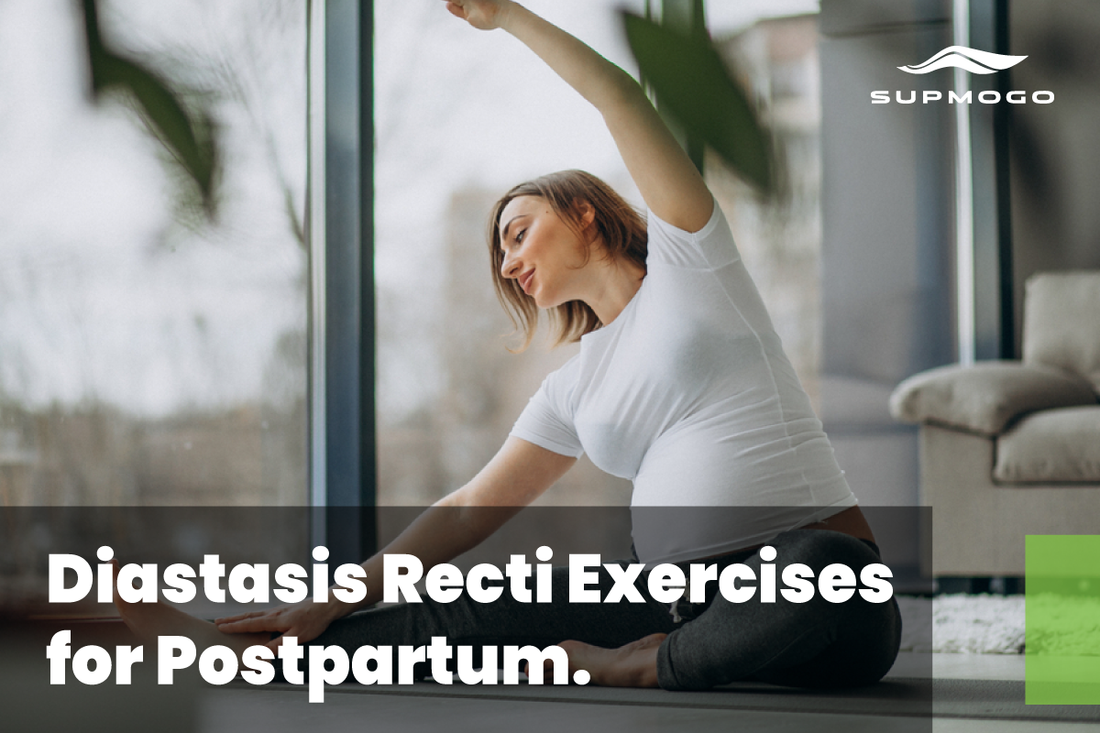Will you be holding your sweet angel in your arms soon, or have you already given birth to your little bundle of joy?
You likely went through many happy and unpredictable phases over the course of these nine months of a roller coaster.
But this happiness does come at the expense of your health. Just like blood pressure, gestational diabetes, and muscular pain, diastasis recti, diastasis postpartum, or pregnancy, is a medical term that can be extremely distressing.
About three-fourths of pregnant or postpartum women go through diastasis recti. Your newborn baby can also face this issue, but don't fret; babies can get better on their own with time. [1]
Diastasis recti is usually caused by having more than one baby or becoming pregnant in a short period of time.
There's no need to worry about it as it's not a dangerous disease, and you know what? Men can also face this problem. You can easily overcome this issue with proper diastasis recti exercise, diet, and treatment.
But wait—you must be wondering what this Diastasis Retic is. This article provides a thorough explanation of the issue as well as some potential solutions, including diastasis recti workouts and exercises.
Here’s what you’ll learn in this article.
- What is Diastasis Recti?
- Symptoms of Diastasis Recti
- Top 4 Diastasis Recti Exercises
- Transverse Abdominal Breathing
- Bent Knees
- Pelvic Tilts on Hands and Knees
- Toe Taps Lying on Back
- SUPMOGO Regenerative Wearable Belt
What is Diastasis Recti?
Diastasis recti is a condition caused by small gaps between your stomach's left and right muscles.
It is also called "pooch" or "bulkiness of the stomach." By performing some specific exercises for diastasis recti, you can regain your stomach's shape within a short time.
According to research, your body might change unconditionally during and after pregnancy because of the growing life inside you. Your muscles stretch during pregnancy, due to which the left and right sides of the abdominis rectus muscles lose their place. [2]
Some separations are normal and don't need any extra care. They settle with time, but some separations are not normal; they need proper guidance to get back on track.
Firstly, you must watch out for the symptoms if your stomach is going through diastasis recti and needs postpartum exercise after delivery. Below are the symptoms you should check out to highlight your problem.
Symptoms of Diastasis Recti
- A visible pooch below or above your belly button
- Bloating or constipation
- Lower back pain
- Difficulty in walking, lifting objects, and doing daily chores
- Heavy breathing
- Painful intercourse
- Loss of abdominal control
Studies reveal that some abdominal and pelvic floor muscle exercises can help treat diastasis recti. [3]
Top 4 Diastasis Recti Exercises
If you experience any of the aforementioned symptoms, see your doctor to get a diagnosis. Also, you can start doing these four exercises for diastasis recti to regain your stomach's structure perfectly.
1. Transverse Abdominal Breathing
The transverse abdominal muscle is very important in the human body; most of you must learn what this muscle is and its functions.
The transverse muscle helps in heavy breathing like coughing, sneezing, or blowing out a candle or balloon. When performing this exercise, you must relax your chest, close your mouth, and maintain silent breathing.[4]
To perform this exercise:
- Straightly, stand on a raised platform while keeping your one leg higher than the surface and keeping your body's weight inside your other leg.
- You can take support from an external object to keep your body balanced and avoid falling.
- Now drop your leg below without touching the floor and raise it as much as possible until one side of your pelvis is higher than the other.
- Repeat this action almost 15 times, and then go for another leg.
- You have to perform this exercise almost 30 times, 15 times with each side daily.
TVA is the most common and easy postpartum diastasis recti exercises you can do at your home without any difficulty
2. Bent Knees
The best way to treat diastasis recti is to rebuild your roots from the inside out, like a red brick. Another great diastasis recti exercise postpartum to gain your figure like a pro is bent knee fallout.
Here's how you can do this exercise:
- Relax your body first; lie on your back while keeping both feet flat on the surface.
- Now raise your knees to 90 degrees, and start taking deep breaths.
- Start Floating your knees towards the opposite side while keeping your pelvic area still; your pelvis does not move during the knee rotation. Keep it in a statue position.
- Stretch your knees as much as possible. Now release your breath and draw your legs to your body slowly.
- Also, focus on your hip's position; they should be placed on the surface evenly during the workout, while keeping your pelvic area stuck to the floor.
Repeat this exercise according to your stamina and strength, as it will not cause any restraint or burden over your stomach muscles; it will work wonders to solve your diastasis recti smoothly.
3. Pelvic Tilts on Hands and Knees
Another amazing movement of hands and knees you can do to join your muscles and keep them in shape while exercising with diastasis recti
Pelvic tilts on hands and knees can help you regain your posture and fill in the gaps in your stomach if done consistently. Exercise may take some time to show results, but its effects are long-lasting.
For doing pelvic tilts on hands and knees:
- Keep your hands and knees in a neutral position to your spine.
- Now inhale heavily or bigger while putting pressure on your rib cage's side.
- Exhale slowly, not immediately, while doing a Kegel, and release your tailbone down while drawing into a curled-up spine.
- Now again, inhale and try to return to your original position neutrally.
- Perform ten tilts on each side by moving slowly and gradually. Take your time with it; relax a bit if you feel exhausted, and start again from step one.
- Remember to relax your glutes and move from lower abs to the above ones.
This exercise will fill your gaps while strengthening your pelvic region and assisting you in regaining abdominal control. It will also help to relieve lower back pain caused by labor and the baby's weight during pregnancy.
4. Toe Taps Lying on Back
Last but not least, the toe taps performed lying on the back are considered one of the best exercises for diastasis recti. You can skip any movement or exercise that may cause strain on your midline, bulge, or outside of your belly.
Toe taps on your back will require you to be alert and maintain proper posture in order to accomplish your desired result. Follow these steps to do this exercise:
- Start by lying flat on your back. Now bring your legs to a tabletop position.
- Keep your knees directly on your hips.
- Remember not to arch your back or weigh your pelvis area.
- Inhale by using your rib cage. Now release your breath slowly as you tap your feet on the floor.
- Keep your pelvis area positioned, and perform the exercise without moving your hips or pelvis.
- Inhale while returning to the neutral position.
- Repeat the exercise 10 times on each side.
- After completing the turns, relax on the floor for a few seconds, then stand up slowly, keeping your back straight.
These exercises are highly effective if you perform them consistently and patiently.
SUPMOGO RecoveryFlex System
Looking for the easiest way to get into shape after pregnancy? Or are you simply sick of dealing with the back pain you experienced after giving birth to your child? Whatever the case may be, the SUPMOGO Back Pain Relief Belt is sure to be a lifesaver.
World-class doctors and engineers designed it for health-conscious ladies just like you who can't gamble with their well-being at any cost. Read the 10 Huge Benefits of Using the SUPMOGO Recovery Flex System Belt. The Advanced Targeting Technology from SUPMOGO will hasten your recovery from cramps, stiffness, soreness, and backaches.
A remarkable feature of this belt is that it will isolate the origin of your pain by itself and deliver targeted therapy only to the area that needs it. No other massage gun or back pain relief belt can provide such a strong and precise approach to recouping your pain.
So, what are you waiting for? Check us out on our website and click “Add to Cart” to begin your journey to pain-free living.
Also Read: Top Five Ways to Alleviate Lower Back Pain | A Comprehensive Guide.
Conclusion
Our SUPMOGO team wishes you the speediest and healthiest recovery possible!
Remember, you are unstoppable. Don't let anything stand in your way; simply perform the above four postpartum diastasis recti exercises or get your hands on the SUPMOGO fitness wearable belt to regain your health and vitality.
It is important to remember that these exercises can easily close the two- or three-inch gap. Journal of women’s health physical therapy, 29(1), 11-16.
[2] Lof, M., Olausson, H., Bostrom, K., Janerot-Sjöberg, B., Sohlstrom, A., & Forsum, E. (2005). Changes in basal metabolic rate during pregnancy are related to changes in body weight and composition, cardiac output, insulin-like growth factor I, and thyroid hormones, as well as fetal growth. The American journal of clinical nutrition, 81(3), 678-685.
[3] Gluppe, S. B., Engh, M. E., & Bø, K. (2020). Immediate effect of abdominal and pelvic floor muscle exercises on interrecti distance in women with diastasis recti abdominis who were parous. Physical Therapy, 100(8), 1372-1383.
[4] Thabet, A. A., & Alshehri, M. A. (2019). Efficacy of deep core stability exercise program in postpartum women with diastasis recti abdominis: a randomized controlled trial. Journal of musculoskeletal & neuronal interactions, 19(1), 62.

